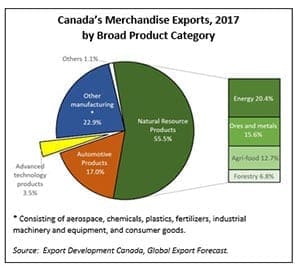 Canada is a relatively small economy that depends heavily on international trade to underpin its prosperity.
Canada is a relatively small economy that depends heavily on international trade to underpin its prosperity.
An examination of what Canada sells to other countries sheds light on the industry sectors in which we possess competitive strengths. It stands to reason that the industries that supply the bulk of our exports are also the ones in which Canada enjoys some degree of global comparative advantage.
Unfortunately, many of our politicians don’t appear to think this way. Rather than asking what the country is actually good at producing and exporting, they dream about a future economy with a different industrial structure – typically, a structure in which ‘green’ and ‘high-tech’ goods and services predominate.
There’s no doubt that tomorrow’s economy will be greener and more technologically sophisticated than the one we have now. But industrial transitions don’t happen overnight – they unfold over multiple generations. Nor do politicians generally have a decisive role in determining the details of the evolving industrial structure.
The chart on the left shows the composition of Canada’s international merchandise exports as of 2017, by broad product category. Canada sold $502 billion worth of goods to other countries last year, along with $113 billion of services. Here we focus on goods only, as they constitute more than four-fifths of Canada’s total exports.
A few things stand out from the chart.
The first is the crucial place of natural resources in the export mix. In 2017, natural resource products accounted for 55 percent of Canada’s merchandise exports (for the four western provinces combined, the share was higher, closer to 80 percent). Energy alone represented more than one-fifth of the country’s goods exports last year, with oil by far the largest contributor. By any measure, natural resources carry enormous weight in our economy and remain foundational to Canada’s exports.
A second striking feature of the chart is the outsized contribution of the automobile sector – both vehicle assembly and parts – to the Canadian export economy: about 17 percent of merchandise export receipts in 2017, with most of this based on shipments to the United States. This underscores the importance of preserving the integrated North American automobile manufacturing sector at a time when the North American Free Trade Agreement (NAFTA) is being renegotiated at the behest of a protectionist-minded American administration.
A third point is the very modest role of what Export Development Canada classifies as “advanced technology products” within Canada’s overall export basket. All advanced technology products together provide less than four percent of the country’s merchandise exports. And the ‘clean tech’ products that garner so much attention from many contemporary politicians make up perhaps one percent of Canada’s exports – a sliver, albeit one that’s expected to grow in coming years.
At a time when Canada is seeing investment dollars and production activity migrate to the U.S. and other jurisdictions across the entire array of natural resource industries, as well as in many segments of manufacturing, our policy-makers should be working harder to bolster the competitive position of the industries that pay the bills today.
Instead, they’re ruminating about a hoped-for economic future whose shape is largely beyond their control.
Jock Finlayson is executive vice-president of the Business Council of British Columbia.
The views, opinions and positions expressed by columnists and contributors are the author’s alone. They do not inherently or expressly reflect the views, opinions and/or positions of our publication.


